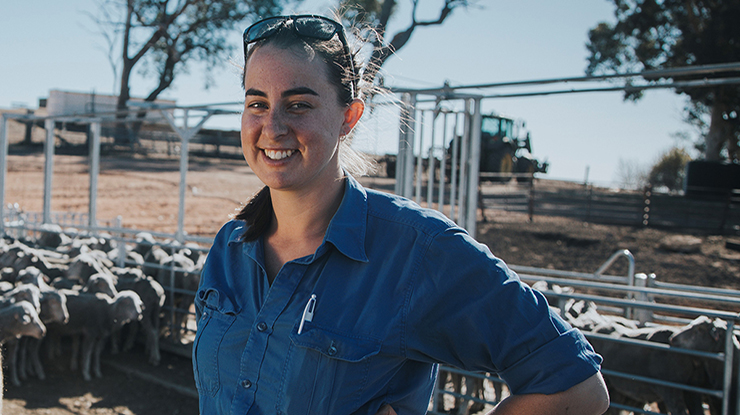 WA sheep producer Emily Stretch.
WA sheep producer Emily Stretch.
Future climates no stretch with resilient strategies
Emily Stretch describes her childhood self as 'the kid who would fly off the school bus straight into the shearing shed’.
So it is no surprise she’s now helping run the fourth-generation family farm.
The Stretch family run a mixed farming operation at Mobrup, south of Kojonup in WA’s south-west.
In addition to cropping, they run a fully non-mulesed flock of 10,000–16,000 Merinos, 5,000 of which are breeding ewes.
Emily cites climate variability as her greatest challenge as a producer.
“Season to season, things are different compared to the patterns my granddad saw,” she said.
“Rainfall has always been variable, but it is more volatile now. We might have a massive dump of rain come through in March, but then this year, May was dry, which is very unusual for this region. We’re also seeing higher temperatures during summer.”
When Dr Kevin Foster and the FutureSheep team approached Emily to be involved in the SheepLinks project, she jumped at the chance.
“They were looking for people in the Kojonup area, and Kevin has one of those brains that I want to be able to dive into and absorb as much of his knowledge as I possibly can.”
Future climates
Emily is supplying the property’s historical rainfall data, which will be fed into models built by the SheepLinks team to predict what the region’s climate might look like in 2030 and 2050, depending on different levels of greenhouse gas emissions.
“I learned from the modelling that we would have higher temperatures over summer, which may impact the fertility of rams and ewes, because we join in February.”
Emily said brutal winters over the past couple of years have also impacted their lambing percentages.
On-farm action
To mitigate the impact of these extremes, Emily is implementing a program of improvements. Her end goal is to have shade and shelter points in every paddock to:
- reduce lamb losses during the cold driving rains in winter
- provide cooling shade during summer.
“I’d like those to be a combination of forage shrubs and shade trees, which will help mitigate our autumn feed gap,” she said.
“As we’ve been going through this with Kevin’s group, I’ve realised it’s a nobrainer, because it has so many aspects which help farming regardless of whether it’s hotter or colder.”
Other adaptations she is implementing include reducing their reliance on monocultures in their pastures so that, irrespective of rain and temperature, one or more species will be thriving.
Longer term, Emily plans to renovate pastures and redesign paddocks for better utilisation, creating alleyways of forage and shelter to protect stock from any given point on the compass.
The SheepLinks modelling also flagged increasing rainfall variability, so Emily is targeting improvements to their water system to reduce reliance on dams.
According to Emily, while her family’s approach to farming hasn’t changed very much over the years, advances in knowledge available to them – such as from SheepLinks – have allowed them to be more productive.
“We’ve always been a family which values how this land is looked after,” she said.
“The mechanisation, the technology, the genetics and the farming techniques have allowed us to make leaps and bounds in our production system, without compromising how this land functions.”
|
Enterprise snapshot:
Annual average rainfall: 550mm |



